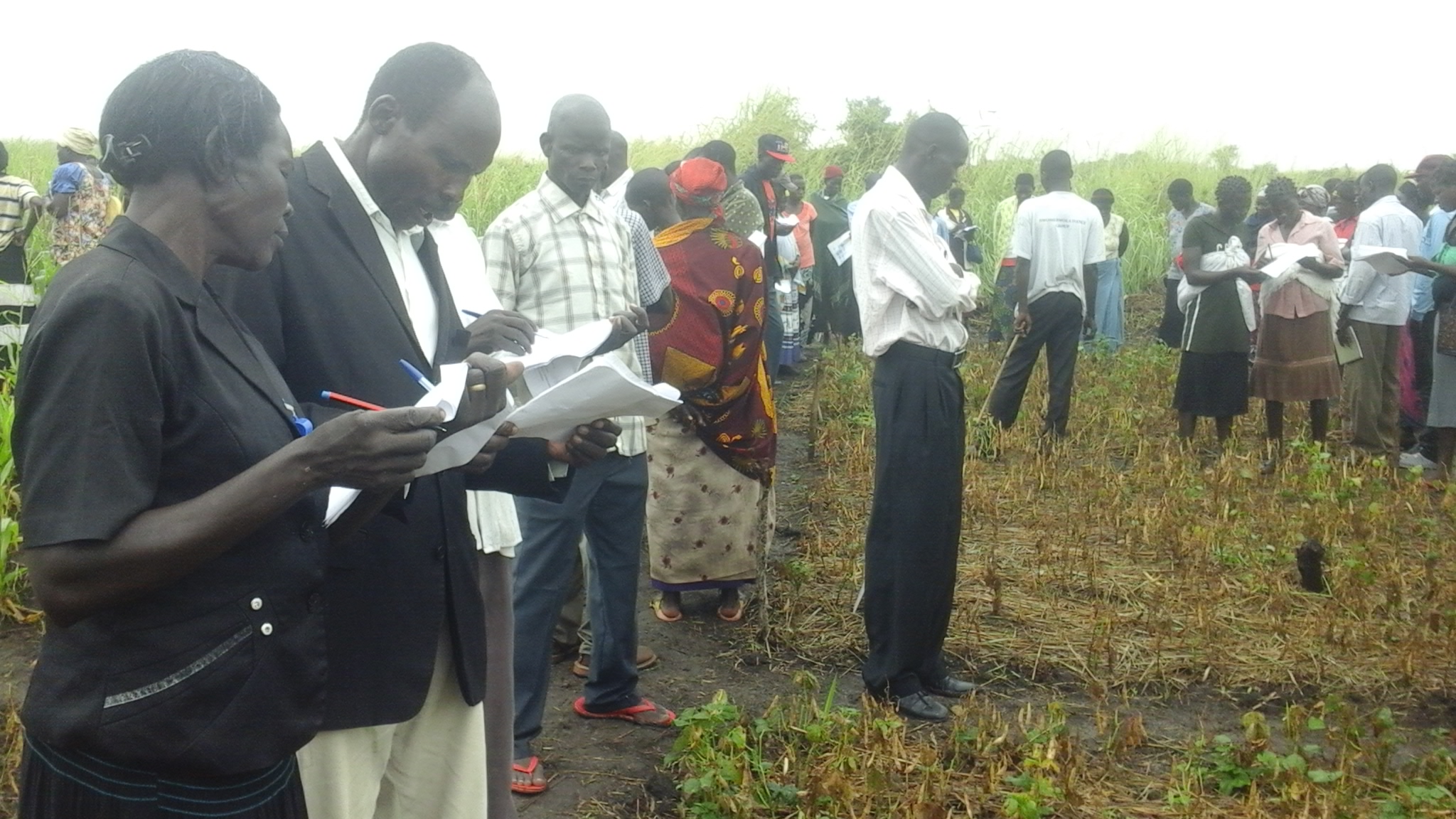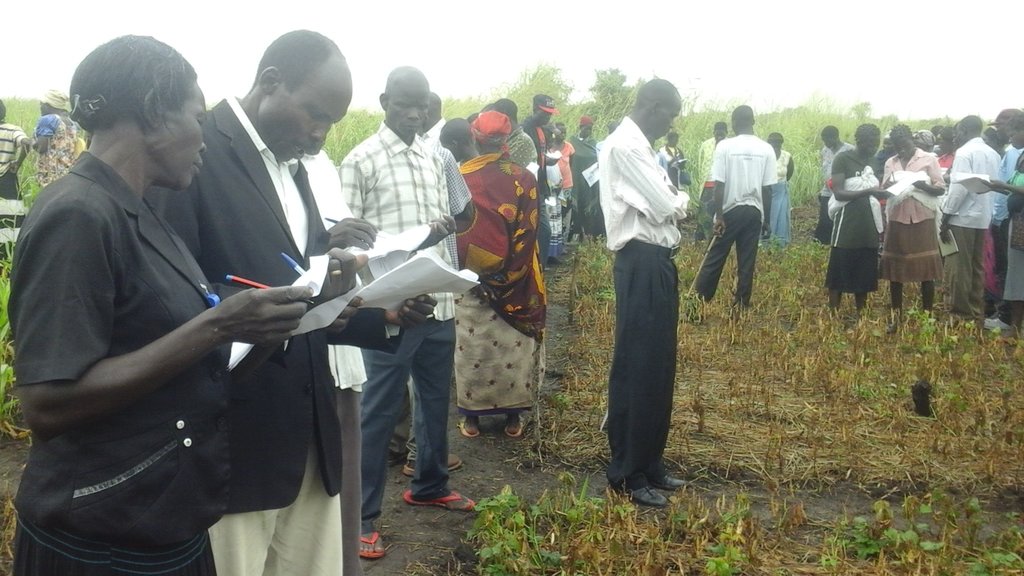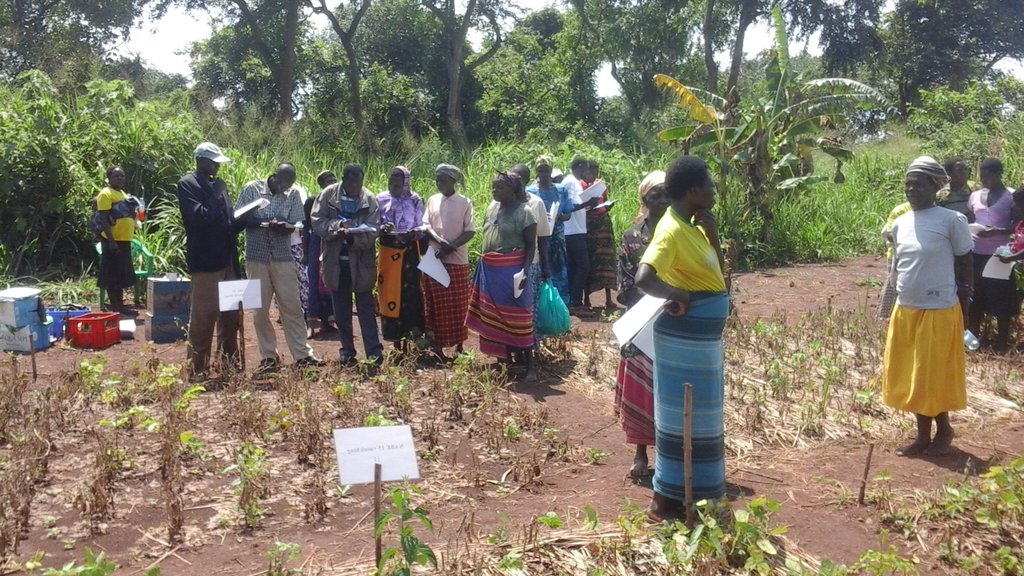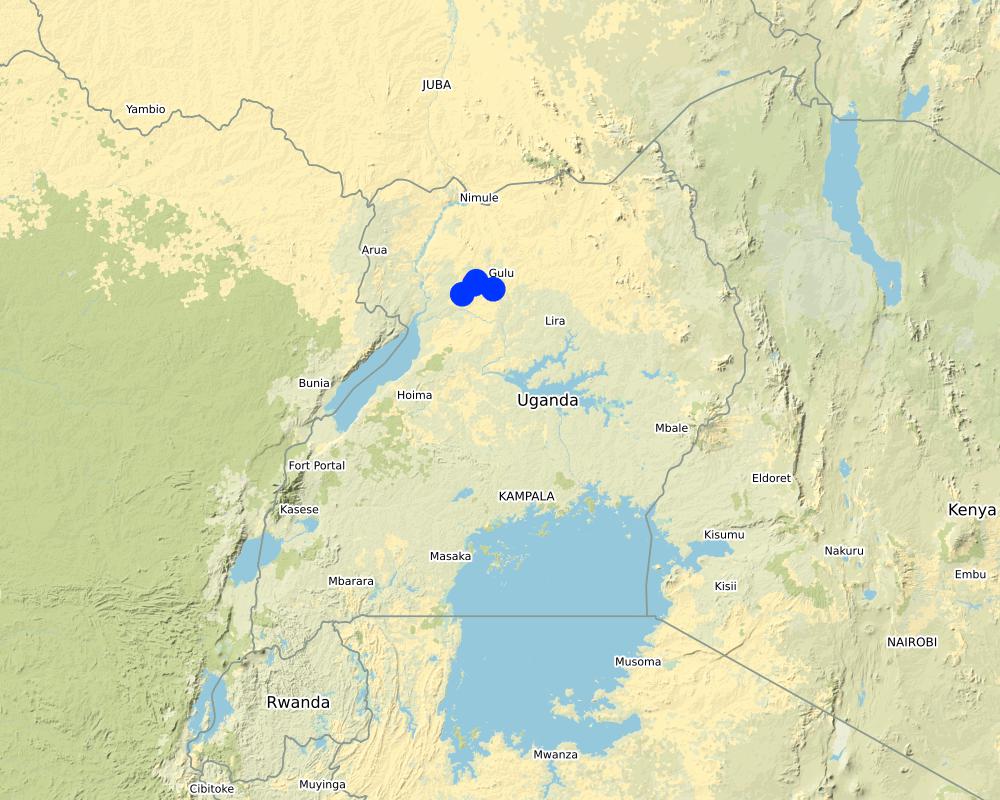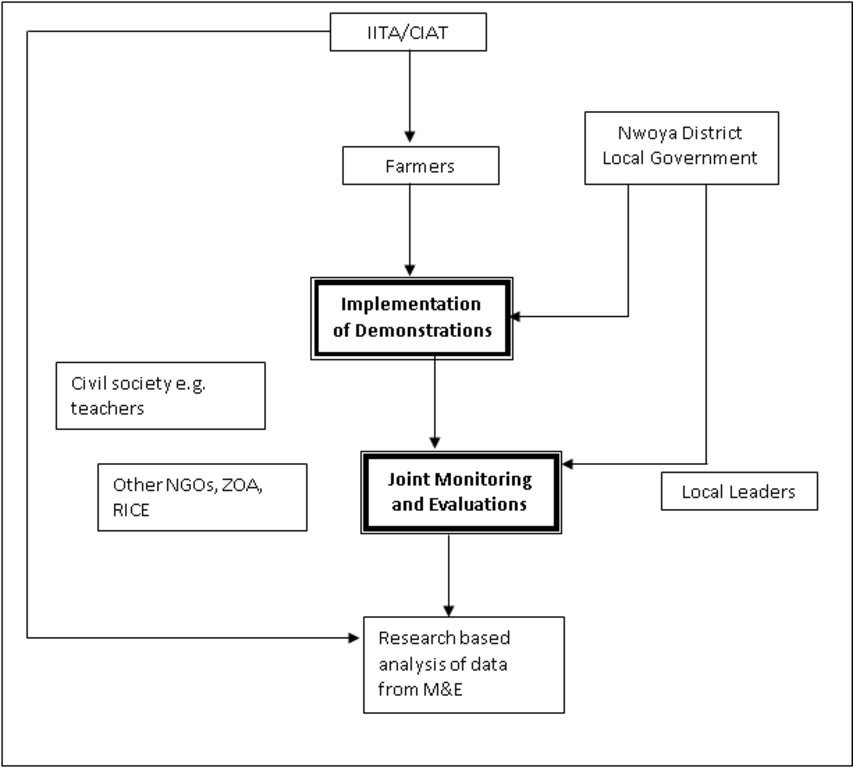Participatory Monitoring and Evaluation of Demonstration Plots [乌干达]
- 创建:
- 更新:
- 编制者: Sunday Balla Amale
- 编辑者: JOY TUKAHIRWA
- 审查者: Udo Höggel
Lwak kamoko ber pa diro
approaches_3370 - 乌干达
查看章节
全部展开 全部收起1. 一般信息
1.2 参与方法评估和文件编制的资源人员和机构的联系方式
有助于对方法进行记录/评估的项目名称(如相关)
Scaling-up SLM practices by smallholder farmers (IFAD)有助于对方法进行记录/评估的机构名称(如相关)
Makerere University (Makerere University) - 乌干达1.3 关于使用通过WOCAT记录的数据的条件
(现场)数据是什么时候汇编的?:
14/11/2017
编制者和关键资源人员接受有关使用通过WOCAT记录数据的条件。:
是
2. SLM方法的描述
2.1 该方法的简要说明
In Participatory Monitoring and Evaluation of demonstrations, all the players or stakeholders involved in the implementation of the demonstration come together to carry out a joint monitoring and evaluation of the performance of the technology being implemented.
2.2 该方法的详细说明
该方法的详细说明:
Demonstration plots established to train farmers are common channels through which recommended farming practice(s) are demonstrated to local farmers. During this process, all the relevant stakeholders in the agricultural sector, for example farmers, local leaders and government extension officers, partner organisations, and the lead implementing agency plan together on how best to implement the demonstration with emphasis on the host community, their roles and responsibilities so as to ensure successful implementation of the demonstration.
Stakeholders involved include:
•Group and community members (women, youth and men)
•Local leaders and authorities
•Civil servants
•Partner Non-Governmental Organisations (NGOs)
•Lead implementing agencies (International Institute of Tropical Agriculture, IITA and International Center for Tropical Agriculture, CIAT)
For the subsequent monitoring and evaluation (M&E) process, the participating stakeholders are invited for a field day on the site of the demonstration. Such M&E process is performed twice or three times during implementation of the demonstration activities depending on necessity, availability of time and resources. The M&E tool is designed by the M&E officer in the organization (IITA/CIAT) supported by the Field Officer/Research Assistant who is responsible for carrying out the field activities. The emphasis of the M&E process is on the goals and objectives, sustainability and adaptive nature, socio-economic and political environment, gender and policy considerations and impacts of the project being implemented. Group members help identifying the stakeholders in their community who can be resourceful in evaluating the demonstrations.
The Participatory Monitoring and Evaluation (PM&E) of the demonstration process, activities and performance is then carried out. It aims to:
•Assess the technology/practice(s) in question in terms of crop vigour and yield
•Understand the resilience of the practice to local prevailing climatic and weather conditions
•Assess whether equal opportunity was given for all community members to participate
•Assess the level of cooperation among group members during meetings
•Understand the gender perspectives with regard to gender equality, woman and youth involvement
•Test for the benefits, performance, pros and cons, and the opportunity cost involved in adopting a demonstrated technology
The PM&E questionnaire is based on IITA/CIAT PM&E tool and is composed of the following chapters:
1.Socio-demographic characteristics: district, sub-county, village, name, telephone contact, age, sex, educational level, employment and group-membership of the participant.
2.Farming characteristics: years of farming experience, total amount of land owned and allocated for farming or particular technology of interest, type of seed (local or improved) and the variety of the crop in question, source of seed and whether or not the participant participated in implementing the demonstration.
3.Implementation performance: Demo-plot location, distance, farmer trainings, demo-management, partnerships in the implementation, participation, cooperation, importance, relevance, monitoring of the demo, involvement in terms of community, gender, youth and the vulnerable groups and attendance.
4.Crop performance: Germination percentage, crop vigour, plant height, number of pods/cobs, pod/cob filling, maturity duration, yield, soil quality, pest occurrence, disease and drought resistance/tolerance.
5.Agro-ecological benefits: This can be ranked in terms of importance of the practice for soil fertility and bio-diversity, adaptation to weather variability and climate change.
6.Socio-economic benefits: This is ranked based on importance for household food and nutrition security, source of income, labour demands and cost of implementation.
7.Participants are then required to rank the technologies monitored.
The scale of ranking ranges from 1 to 5, where 1=Very Unhappy, 2=Unhappy, 3=neither Happy nor Unhappy, 4=Happy, 5=Very Happy. For certain questions, emoji illustrations are also used for the monitoring process.
2.3 该方法的照片
2.5 采用该方法的国家/地区/地点
国家:
乌干达
区域/州/省:
Northern Uganda
有关地点的进一步说明:
Nwoya District
Map
×2.6 该方法的开始和终止日期
若不知道准确的年份,请注明该方法的大致开始日期。:
不到10年前(最近)
2.7 方法的类型
- 基于项目/方案
2.8 该方法的主要目的/目标
All stakeholders appreciate their involvement and hence adopt the technology for purposes of learning and knowledge sharing
2.9 推动或妨碍实施本办法所适用的技术的条件
社会/文化/宗教规范和价值观
- 启动
Corperation among all stakeholders
- 阻碍
Time and resource needed to bring all stakeholders together
财务资源和服务的可用性/可得性
- 启动
This approach enables joint presentation and contribution of projects for funding
机构设置
- 启动
Local farmer groups are activated , share knowledge and information
- 阻碍
Bureaucratic processes in decision making to participate in the process
参与者的的协作/协调
- 启动
Common interest in sustainable agriculture and support to farmer activities
法律框架(土地使用权、土地和水使用权)
- 启动
Presence of rules and regulations that bind the stakeholders to jointly monitor and evaluate as a team
- 阻碍
Poor and weak implementation and enforcement of rules and regulations
政策
- 启动
Local and national policies on bottom up approach where all stakeholders are involved in decision making, starting from the lowest
土地治理(决策、实施和执行)
- 启动
People are able to come together to participate in an activity that is related to land management
- 阻碍
Divergent interests and expectations during monitoring and evaluation
了解SLM,获得技术支持
- 启动
Learning about SLM from the process of monitoring and evaluation
市场(购买投入,销售产品)和价格
- 启动
Affordable prices and quality inputs
- 阻碍
Exploitation by middle men and use of expired inputs on demonstration plots
工作量、人力资源可用性
- 启动
Shared roles and responsibilities among men and women during monitoring and evaluation
- 阻碍
Dominance resulting into conflicts over roles and responsibilities
其他
- 启动
Presence of monitoring and evaluation committee
- 阻碍
Understanding roles and responsibilities of the participatory monitoring and evaluation committee
3. 相关利益相关者的参与和角色
3.1 该方法涉及的利益相关者及其职责
- 当地土地使用者/当地社区
Farmers
Establish the demonstration, carry out activities in demonstrations, monitor and evaluate the demonstration
- 社区组织
Local CBOs
Partipate in M&E of the demonstration
- 研究人员
International Institute of Tropical Agriculture (IITA), International Center for Tropical Agriculture (CIAT)
Introduced the monitoring / evaluation approach, participate in the monitoring process
- 教师/学龄儿童/学生
Teachers from local schools
Participate in monitoring / evaluation
- NGO
Organisation ZOA - from relief to recovery (https://www.zoa-international.com/), other local NGOs
Participate in monitorng / evaluation
- 地方政府
Subcounty and District officials
Participate in monitorng / evaluation
如果涉及多个利益相关者,请注明领导机构:
International Institute of Tropical Agriculture-IITA
3.2 当地土地使用者/当地社区参与该方法的不同阶段
| 当地土地使用者/当地社区的参与 | 指定参与人员并描述活动 | |
|---|---|---|
| 启动/动机 | 互动 | Farmers and local leaders |
| 计划 | 外部支持 | Support from IITA |
| 实施 | 互动 | Farmers, Local leaders, Partner NGOs, IITA |
| 监测/评估 | 互动 | Farmers, Local leaders, Partner NGOs, Policy makers |
| Publication of output | 被动 | IITA as the organisation implementing the project |
3.3 流程图(如可用)
具体说明:
Flow chart showing process that leads to the implementation of participatory monitoring and evaluation
作者:
Sunday Balla
3.4 有关SLM技术选择的决策
具体说明谁有权决定选择要实施的技术:
- 所有相关参与者,作为参与式方法的一部分
明确做出决策的依据:
- 对充分记录的SLM知识进行评估(基于证据的决策)
4. 技术支持、能力建设和知识管理
4.1 能力建设/培训
是否为土地使用者/其他利益相关者提供培训?:
是
明确受训人员:
- 土地使用者
- 现场工作人员/顾问
培训形式:
- 示范区域
4.2 咨询服务
土地使用者有权使用咨询服务吗?:
是
- Demonstration sites identified by farmers
4.3 机构强化(组织发展)
是否通过这种方法建立或加强了机构?:
- 是,适度
具体说明机构的强化或建立程度:
- 本地
- 区域
- 国家
具体说明支持类型:
- 能力建设/培训
4.4 监测和评估
监测和评估是该方法的一部分吗?:
是
注释:
It is the exact approach
若是,该文件是否用于监测和评估?:
是
4.5 研究
研究是该方法的一部分吗?
是
明确话题:
- 生态学
提供进一步的细节,并指出是谁做的研究:
IITA-Climate Smart Agriculture Research. Research focused on increasing food security and farming systems' resilience in East Africa
5. 融资和外部物质支持
5.1 该方法中SLM组成部分的年度预算
如果不知道准确的年度预算,请给出一个范围:
- 2,000-10,000
5.2 为土地使用者提供财政/物质支援
土地使用者是否获得实施该技术的财政/物质支持?:
否
5.3 对特定投入的补贴(包括劳动力)
- 无
如果土地使用者的劳动力是一项重要的投入,那么是不是:
- 自愿
5.4 信用
是否根据SLM活动的方法给予信用值?:
否
5.5 其它激励或手段
是否有其他激励措施或工具用于促进SLM技术的实施?:
是
如果是,请具体说明:
Refreshments during PM&E and demonstration activities eg. water or soft drinks
6. 影响分析和结论性陈述
6.1 方法的影响
该方法是否有助于当地土地使用者,提高利益相关者的参与度?:
- 否
- 是,很少
- 是,中等
- 是,支持力度很大
Local users understand what kind of paramenters can be considered for an evaluation
这种方法是否有助于基于证据的决策?:
- 否
- 是,很少
- 是,中等
- 是,支持力度很大
The approach enables farmers to take decisions based on what they observed during the evaluation process
该方法是否提高了SLM的协调性和成本效益?:
- 否
- 是,很少
- 是,中等
- 是,支持力度很大
All stakeholders took part in the implementation and PM&E process. This improved coordination and resource sharing
该方法是否调动/改善了使用财务资源实施SLM的途径?:
- 否
- 是,很少
- 是,中等
- 是,支持力度很大
Stakeholder platform helps to share and identify potential sources of resource and fund mobilisation
该方法是否提高了土地使用者实施土地管理的知识和能力?:
- 否
- 是,很少
- 是,中等
- 是,支持力度很大
Each participant understood in depth the process involved in implementing a given technology
该方法是否提高了其他利益相关者的知识和能力?:
- 否
- 是,很少
- 是,中等
- 是,支持力度很大
Participants learned important indicators for demonstrations and how to assess them
该方法是否建立/加强了机构、利益相关者之间的合作?:
- 否
- 是,很少
- 是,中等
- 是,支持力度很大
Many stakeholders were part of the platform, ranging from local schools and institutions as part of the civil society
该方法是否缓解了冲突?:
- 否
- 是,很少
- 是,中等
- 是,支持力度很大
Participants learned how to collaborate in groups
该方法是否有助于社会和经济弱势群体?:
- 否
- 是,很少
- 是,中等
- 是,支持力度很大
All community members were invited to learn and participate hence acquiring knowledge
该方法是否改善了性别平等并赋予女性权力?:
- 否
- 是,很少
- 是,中等
- 是,支持力度很大
The approach involved all age groups and gender with focus on widows
该方法是否鼓励年轻人/下一代土地使用者参与SLM?:
- 否
- 是,很少
- 是,中等
- 是,支持力度很大
Youth were at the forefront of implementation
该方法是否改善了阻碍SLM技术实施的土地使用权/用户权问题?:
- 否
- 是,很少
- 是,中等
- 是,支持力度很大
Participants learned about the importance of learning and the allocation for various activities. ZOA carried out land and conflict resolutions and helped farmers acquiring land titles from the Government
该方法是否改善了粮食安全/改善了营养?:
- 否
- 是,很少
- 是,中等
- 是,支持力度很大
Participants identify which technology addresses their food and nutrition security needs
该方法是否改善了市场准入?:
- 否
- 是,很少
- 是,中等
- 是,支持力度很大
Farmers identify which technology is a suitable income basing on the available market opportunities
该方法是否改善了供水和卫生条件?:
- 否
- 是,很少
- 是,中等
- 是,支持力度很大
The approach utilized local community group which also carry out Savings, borehole maintenance and community Village Health teams
该方法是否提高了土地使用者适应气候变化/极端情况和减轻气候相关灾害的能力?:
- 否
- 是,很少
- 是,中等
- 是,支持力度很大
Farmers identify technologies, resilient to weather variability and weather extremes
6.2 土地使用者实施SLM的主要动机
- 增加生产
High yields of crops
- 增加利润(能力),提高成本效益比
Market available for the products from SLM technology
- 减少土地退化
Soil and fertility management
- 降低灾害风险
Reduced risks of drought, pest and disease incidences, floods
6.3 方法活动的可持续性
土地使用者能否维持通过该方法实施的措施(无外部支持的情况下)?:
- 是
若是,请说明如何维持:
During the PM&E Process, the land users are required to indicate their interest in the adoption of particular technologies and the challenges they would face. Therefore this process enables the farmers to know the requirements for implementing a given technology, pros and cons and how to sustain it economically and environmentally.
6.4 该方法的长处/优点
| 土地使用者眼中的长处/优势/机会 |
|---|
| It is participatory |
| All stakeholders are involved |
| Individual opinions is considered |
| 编制者或其他关键资源人员认为的长处/优势/机会 |
|---|
| It is a research based approach and quantitative data can be obtained from such an approach |
| Basic sign and labels on the PM&E tool is easy for local farmers to understand |
6.5 该方法的弱点/缺点以及克服它们的方法
| 土地使用者认为的弱点/缺点/风险 | 如何克服它们? |
|---|---|
| The participants may not understand clearly what information is required of them. This can be due to misunderstanding of questions, indicators and possible responses if they are not properly explained. | Eloquent speaker of the local language should act as enumerator to clearly explain what is required of the participants. This can be coupled with emoji illustrations besides the questionnaire. |
| 编制者或其他关键资源人员认为的弱点/缺点/风险 | 如何克服它们? |
|---|---|
| Simple, visible and easy to understand attributes or parameters are considered. for example plant yield, vigor, participation. Some factors like long term benefits, cost benefit considerations were not included. | Perceptions and Attitudes, Simple cost benefit considerations can be included in the evaluation. |
7. 参考和链接
7.1 方法/信息来源
- 实地考察、实地调查
All stakeholders involved during the field day activity should participate in the PM&E
链接和模块
全部展开 全部收起链接
无链接
模块
无模块


